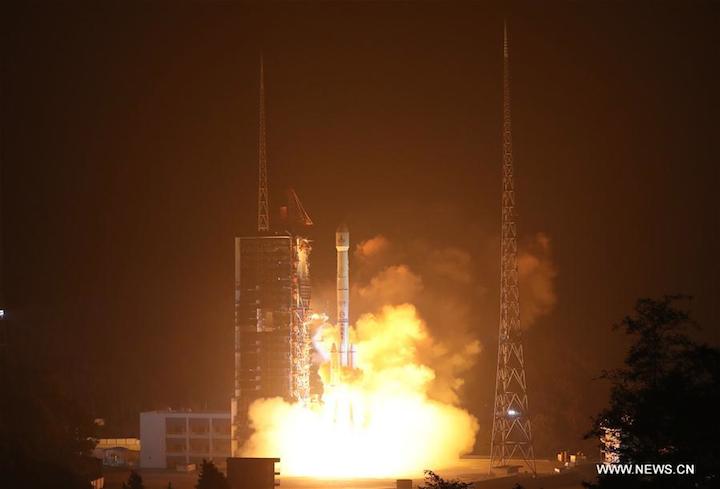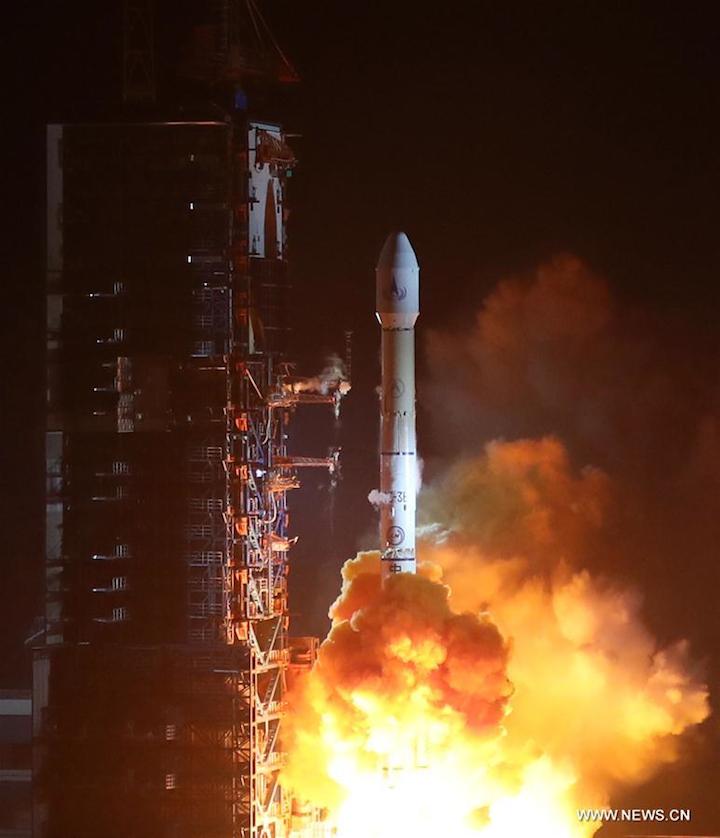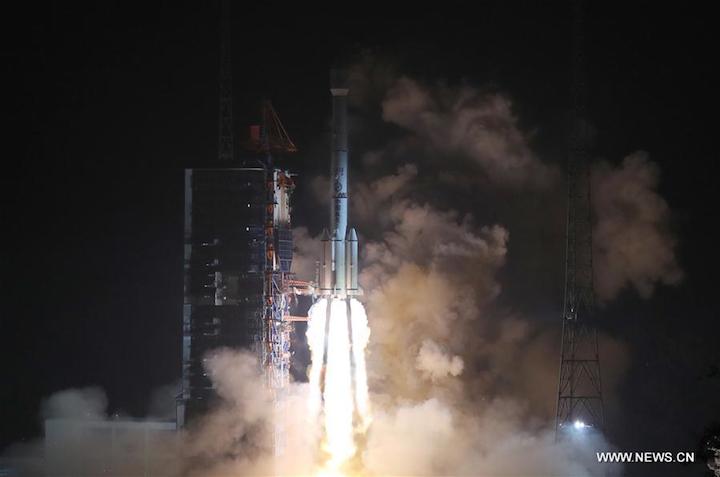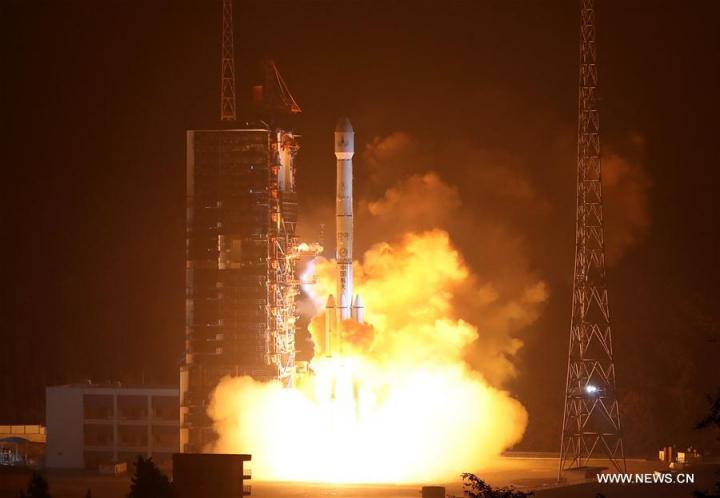.
China launches new-generation weather satellite

A Long March-3B rocket carrying the Fengyun-4 satellite blasts off from the launching pad at Xichang Satellite Launch Center, southwest China's Sichuan Province, Dec. 11, 2016. China launched the weather satellite at 12:11 a.m. Sunday, marking an upgrade of China's meteorological satellites in geostationary orbit. The Fengyun-4 satellite, the first of China's second-generation weather satellites in geostationary orbit to have been launched, is also the country's first quantitative remote-sensing satellite in high orbit. (Xinhua/Chen Jianli)
XICHANG, Sichuan, Dec. 11 (Xinhua) -- China launched a weather satellite at 12:11 a.m. Sunday, marking an upgrade of China's meteorological satellites in geostationary orbit.
The Fengyun-4 satellite, the first of China's second-generation weather satellites in geostationary orbit to have been launched, is also the country's first quantitative remote-sensing satellite in high orbit.
The satellite, launched from the Xichang Satellite Launch Center in southwest China's Sichuan Province, was taken into orbit by a Long March-3B carrier rocket. The launch marked the 242nd mission of China's Long March series of rockets.
The satellite will make high time, spatial and spectral resolution observations of the atmosphere, clouds and space environment of China and surrounding regions, significantly improving capabilities of weather and climate forecasts, according to the State Administration of Science, Technology and Industry for National Defense.
The China Meteorological Administration is the primary user of the satellite.
Previously, China had successfully launched 14 weather satellites, seven of which are still in orbit.
.

A Long March-3B rocket carrying the Fengyun-4 satellite blasts off from the launching pad at Xichang Satellite Launch Center, southwest China's Sichuan Province, Dec. 11, 2016. China launched the weather satellite at 12:11 a.m. Sunday, marking an upgrade of China's meteorological satellites in geostationary orbit. The Fengyun-4 satellite, the first of China's second-generation weather satellites in geostationary orbit to have been launched, is also the country's first quantitative remote-sensing satellite in high orbit. (Xinhua/Chen Jianli)

A Long March-3B rocket carrying the Fengyun-4 satellite blasts off from the launching pad at Xichang Satellite Launch Center, southwest China's Sichuan Province, Dec. 11, 2016. China launched the weather satellite at 12:11 a.m. Sunday, marking an upgrade of China's meteorological satellites in geostationary orbit. The Fengyun-4 satellite, the first of China's second-generation weather satellites in geostationary orbit to have been launched, is also the country's first quantitative remote-sensing satellite in high orbit. (Xinhua/Chen Jianli)

A Long March-3B rocket carrying the Fengyun-4 satellite blasts off from the launching pad at Xichang Satellite Launch Center, southwest China's Sichuan Province, Dec. 11, 2016. China launched the weather satellite at 12:11 a.m. Sunday, marking an upgrade of China's meteorological satellites in geostationary orbit. The Fengyun-4 satellite, the first of China's second-generation weather satellites in geostationary orbit to have been launched, is also the country's first quantitative remote-sensing satellite in high orbit. (Xinhua/Chen Jianli)
Quelle: Xinhua
---
China launches Fengyun-4A weather satellite in 20th space mission of 2016
 A Long March 3B launching the Thales Alenia Space-made Zhongxing-12 satellite from Xichang in November 2012.
A Long March 3B launching the Thales Alenia Space-made Zhongxing-12 satellite from Xichang in November 2012.China on Saturday successfully launched the first of its new generation of geostationary weather satellites, Fengyun-4A, marking a national record 20th space launch for 2016.
Fengyun-4A was launched by Long March 3B carrier rocket from the Xichang Satellite Launch Centre in the southwestern Sichuan Province at 01:11 on Sunday Beijing time (16:11 UTC Saturday).
The 5,400kg FY-4A is the experimental first spacecraft in a new series of meteorological satellites. Fengyun-4 satellites will carry four main instruments for enhanced imaging, vertical atmospheric sounding, lightning mapping and space environment monitoring.
Orbiting at an altitude of 35,786 kilometres, the satellites will provide high spatial, temporal and spectral resolution observations of China and surrounding areas, improving weather forecast and monitoring.
China has three operational Fengyun-2 meteorological satellites in geostationary orbits, which are capable of imaging only. China's Fengyun-1 and -3 series are two generations of polar-orbiting meteorological satellites .

Fengyun-4A will be operated by the China Meteorological Administration and was developed by the China Academy of Space Technology (CAST), a research institute under the China Aerospace Science and Technology Corporation (CASC), the space program's main contractor.
The satellites are based on the SAST-5000 platform developed by the Shanghai Academy of Space Technology (SAST) and have an intended operational lifetime of 5-7 years.

Record-breaking year
The Fengyun-4A mission was China's 20th orbital launch of 2016, including one failure, Gaofen-10. 20 launches in a calendar year is a national record for China, while matching the 19 successful launches for 2012 and 2015.
China will attempt another 3-4 launches in December in an intense finish to a record-breaking and breakthrough year.
In November, China launched its largest ever rocket, the Long March 5, which will allow the country to construct a large, modular space station and launch deep space missions, including a 2017 lunar sample return and an ambitious Mars mission in 2020.

Above: Long March 5, lifts off from Wenchang on Nov 3, 2016.
China's first satellite, Dong Fang Hong-1, was launched on a Long March 1 rocket on April 24, 1970. Saturday's launch was the 242nd overall for the Long March rocket series.
Quelle: gbtimes
